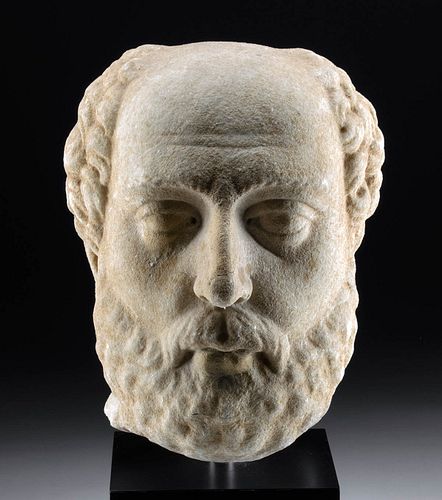Lifesize Roman Marble Head Balding Man with Beard
About Seller
686 S Taylor Ave, Ste 106
Louisville, CO 80027
United States
Selling antiquities, ancient and ethnographic art online since 1993, Artemis Gallery specializes in Classical Antiquities (Egyptian, Greek, Roman, Near Eastern), Asian, Pre-Columbian, African / Tribal / Oceanographic art. Our extensive inventory includes pottery, stone, metal, wood, glass and textil...Read more
Two ways to bid:
- Leave a max absentee bid and the platform will bid on your behalf up to your maximum bid during the live auction.
- Bid live during the auction and your bids will be submitted real-time to the auctioneer.
Bid Increments
| Price | Bid Increment |
|---|---|
| $0 | $25 |
| $300 | $50 |
| $1,000 | $100 |
| $2,000 | $250 |
| $5,000 | $500 |
| $10,000 | $1,000 |
| $20,000 | $2,500 |
| $50,000 | $5,000 |
| $100,000 | $10,000 |
| $200,000 | $20,000 |
About Auction
Nov 10, 2022
Museum-worthy examples of classical antiquities (Egyptian, Greek, Roman, Near Eastern), Viking, Far East / Asian, Pre-Columbian, African / Tribal, Oceanic, Native American, Spanish Colonial, Nautical, Fossils, Ancient Jewelry, Fine / Visual Arts, so much more! Artemis Fine Arts info@artemisfinearts.com
- Lot Description
Roman, Imperial Period, ca. 1st to 4th century CE. A masterful, life-size marble portrait of a man displaying a bushy beard and a hairless scalp surrounded by a crown of tufted curls. Gazing forth from sunken eyes, his stoic visage features a sharp brow line, heavy eyelids, a sizable nose, and petite, gently parted lips. Note how the artist took care to portray subtle signs of aging in the light furrowing of his brow, the pouches beneath each eye, and the hollowing of his cheeks. Though not typically considered flattering to modern sensibilities, Roman portrait patrons often chose to be presented with glisteningly bald heads, large noses, and extra wrinkles to express the years they had devoted to the Roman state. In fact, male pattern baldness, as seen in this individual, was considered an ideal characteristic of an upstanding Roman citizen, signifying wisdom, dignity, and gravitas. A superb sculpture replete with expert stylization and an adherence to realism! Size: 7" W x 9.5" H (17.8 cm x 24.1 cm); 15.6" H (39.6 cm) on included custom stand.
In very early Rome, men wore their beards uncut. It was not until 300 BCE, that Roman men shaved their beards as a rule according to Pliny (VII. 59). Pliny notes that P. Ticinius Maenas brought over a barber from Sicily at this time, and from then on, shaving became regular habit. During the later Republican Period, some men partially shaved and trimmed their beards. Interestingly, when mourning, men would allow their beards to grow, but in general, beards during this time were thought to be a mark of the lower classes and slovenliness. In addition, the first time a male shaved was noted as a milestone - a signature of manhood. The emperor Hadrian (reigned 117-138 CE), however, revived the beard. According to Plutarch, he wore a beard to hide scars on his face. Thereafter, beards were favored by emperors until the time of Constantine the Great (reigned 306-337 CE).
Classical Greeks and the Romans who came after them honored notable individuals by sculpting them in marble, often with the intention of placing the sculpture at their tombs. While the Greeks frequently portrayed their subjects as idealized and youthful, the Romans focused more on true physical characteristics. Their attention to details of dress, countenance, and coiffure indicated their subjects' social and political statuses. Romans desired portraits that would express the individual's identity by stressing his age, experience, and lack of vanity. Thus, men were depicted with wrinkles, baldness, and physical imperfections that were thought to convey a sense of their virtus, the quality of selfless duty and sober morality.
Provenance: East Coast collection, New York Gallery, New York City, New York, USA, acquired before 2010
All items legal to buy/sell under U.S. Statute covering cultural patrimony Code 2600, CHAPTER 14, and are guaranteed to be as described or your money back.
A Certificate of Authenticity will accompany all winning bids.
We ship worldwide and handle all shipping in-house for your convenience.
#175734Fragment of a larger piece. Professional repair to bridge of nose, lower lip, and right eye with restoration. Newer chip to right side of collar, and light weathering to surface as shown. Otherwise, excellent with nice remaining detail.Condition
- Shipping Info
-
Artemis Gallery will no longer be able to offer in-house shipping for most international orders, as well as all oversized orders, including most paintings. These items are clearly marked in the listing as “3rd Party Shipping Required” in the listing. We have a list of recommended third party shippers to assist you in shipping to and from, and would be happy to assist you in working with them. We require a written authorization from the client to release property to any third party. You may fax a Shipping Release Form to 303-828-3235 or email your authorization to kristen@artemisgallery.com. Please note the all property must be removed from our premises within seven (7) business days following the last day of the auction.
-
- Buyer's Premium



 EUR
EUR CAD
CAD AUD
AUD GBP
GBP MXN
MXN HKD
HKD CNY
CNY MYR
MYR SEK
SEK SGD
SGD CHF
CHF THB
THB














